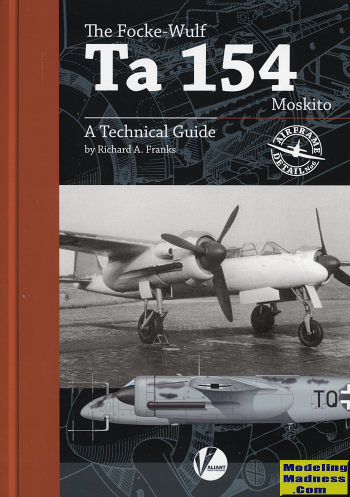 The
next book in Valiant
Wings' Airframe Detail book is on the Focke-Wulf Ta-154 'Moskito'. This is
one of those aircraft that could have been successful, but for a variety of
reasons, never really made it to the big leagues, as they say.
The
next book in Valiant
Wings' Airframe Detail book is on the Focke-Wulf Ta-154 'Moskito'. This is
one of those aircraft that could have been successful, but for a variety of
reasons, never really made it to the big leagues, as they say. |
Author: |
Richard A Franks |
|
Publisher/Distributor |
Valiant Wings Publishing |
|
Price |
£13.95 MSRP at www.valiant-wings.co.uk |
|
Reviewer: |
|
| Notes: | 64 pages, A4 Format, softcover, ISBN: 978-0-9957773-7-8, Airframe Detail #6 |
 The
next book in Valiant
Wings' Airframe Detail book is on the Focke-Wulf Ta-154 'Moskito'. This is
one of those aircraft that could have been successful, but for a variety of
reasons, never really made it to the big leagues, as they say.
The
next book in Valiant
Wings' Airframe Detail book is on the Focke-Wulf Ta-154 'Moskito'. This is
one of those aircraft that could have been successful, but for a variety of
reasons, never really made it to the big leagues, as they say.
The aircraft was envisioned as a German Mosquito, based on how impressed the RLM was by the appearance and performance of the deHavilland product. An August 1942 meeting put out the requirement for the plane to be powered by extant Jumo211F engines and for the airframe to be mostly constructed from plywood. This last requirement turned out to be the death knell for the plane. Unlike the British, the German aero industry never had a reason to build wooden planes like this so had no previous experience, unlike deHavilland. Things got even worse when the lone supplier of the cement used to bond the aircraft parts together was destroyed in an Allied air raid. Subsequent companies did not have the knowledge or experience of making this glue and this resulted in some structural issues in later aircraft.
Development went along rather well as these things go and the prototype flew in July of 1943. There were the usual glitches, but Focke-Wulf continued with prototypes and eventually pre-production aircraft. Increased Allied bombing resulted in production of sub-assemblies being farmed out and this caused issues with parts quality. It also did not help that a considerable number of prototypes were destroyed during a bombing raid. There were delays with things like engines and issues with landing gear collapses that eventually doomed the aircraft. It also didn't help that the aircraft was unable to meet the performance parameters. (In my long life of reading about aircraft, it seems that few designs actually were able to meet specs).
For those unfamiliar with the series, the book provides not only a nice history on the type, but also close-up detail information using period drawings/photos. There are no extant airframes. A part I like is the camouflage and markings section that includes a goodly number of well done full color profiles. Kits of the Ta-154 are available in all the major scales from at least one source. Interestingly, the authors chose the rather pricey 1/32 HPH resin kit for the lone build article. This makes into a superb model, but isn't one that many of us will be building. Appendicies include one that provides information on the various kits produced, in addition to books on the type and various accessories.
In all, it is another superb effort from Valiant Wings and a book that easily gets my highest recommendation.
February 2019
Copyright ModelingMadness.com. All rights reserved.
For more on Valiant Wings, including getting this book, visit www.valiant-wings.co.uk. Thank you for the review copy.
If you would like your product reviewed fairly and quickly, please contact me or see other details in the Note to Contributors.